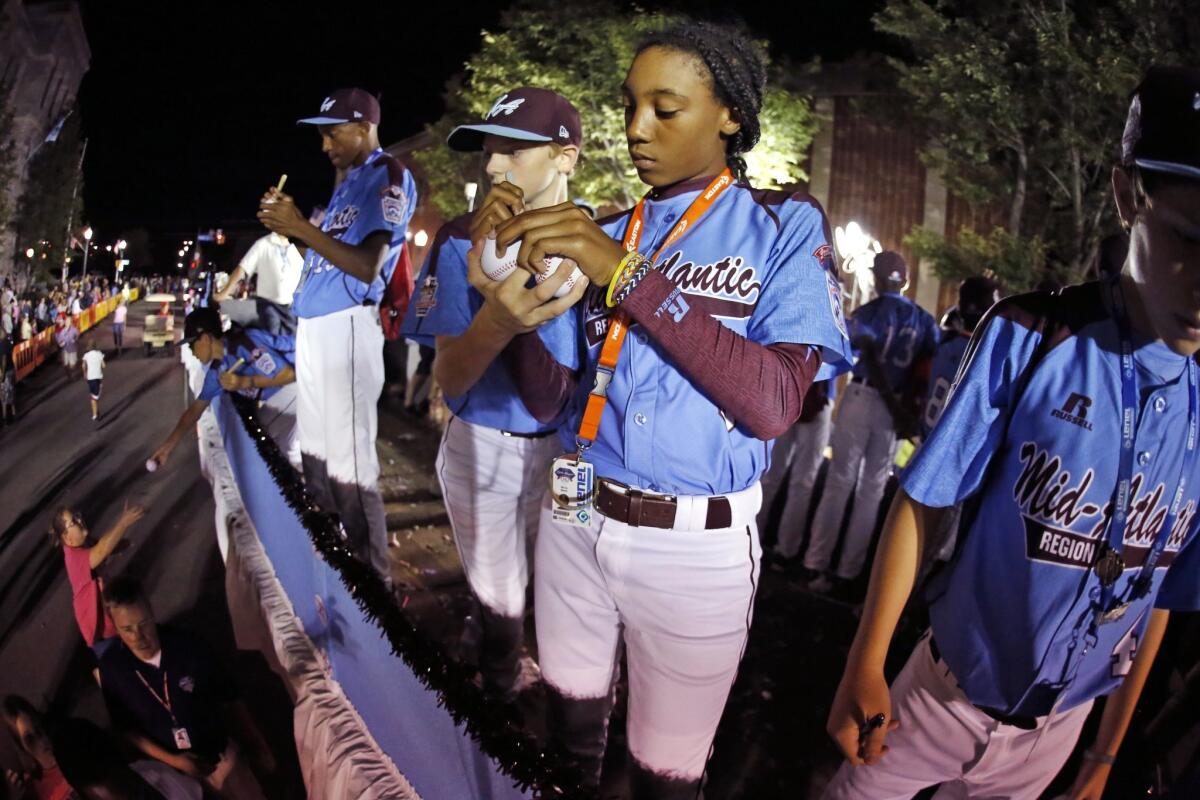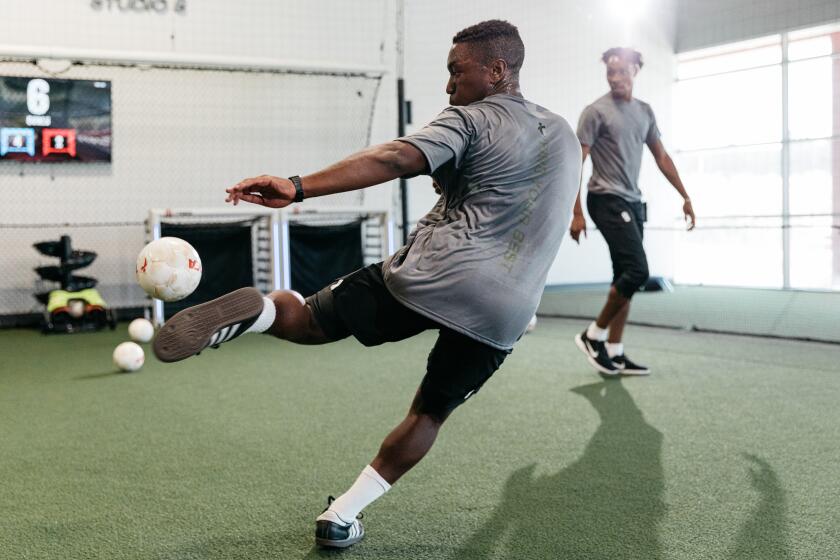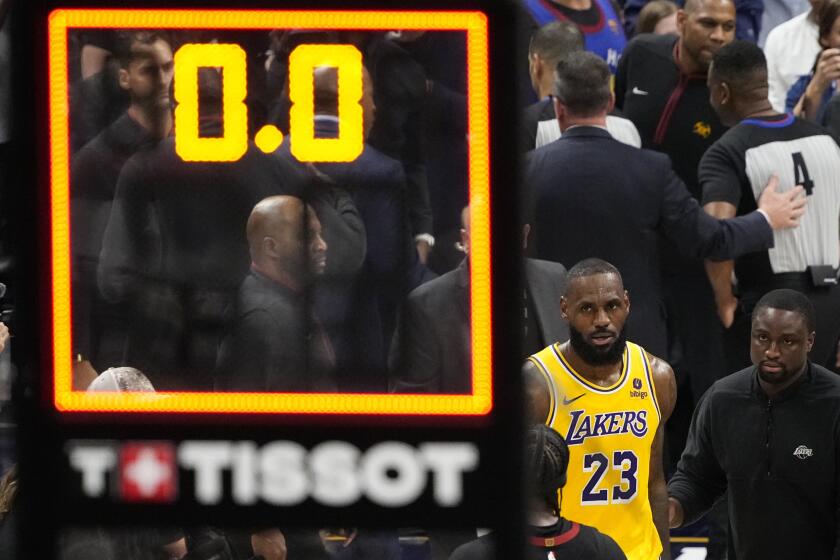Mo’ne Davis’ legacy isn’t done with this Little League World Series

Mo’ne Davis is different.
The 13-year-old from Philadelphia flings curveballs that buckle knees and fastballs that zip 46 feet to home plate at 70 mph. In the last week, Davis became the first girl to throw a shutout in the Little League World Series, the youngest athlete to appear on the cover of Sports Illustrated and, for good measure, attracted a record 34,128 fans to Lamade Stadium in South Williamsport, Pa., on Wednesday to see what the pitcher for the Taney Dragons would do next.
She didn’t just share the field with the boys. She dominated them.
“I throw my curveball like Clayton Kershaw and my fastball like Mo’ne Davis,” she said.
Seventeen other girls have played in the 68-year history of the Little League World Series, but none captured the nation’s attention the same way as the 5-foot-4 dynamo with long hair, a perpetual grin and more than 27,000 Twitter followers. The run ended Thursday with a 6-5 loss to Chicago to eliminate her team, one game from the U.S. championship.
But the same question followed each of Davis’ strikeouts, including six in her final appearance on the mound, an abbreviated 55-pitch appearance against Nevada on Wednesday in which she was not at her best. When will a woman break the decades-old gender barrier to play affiliated minor league baseball?
“I was beaten. People went after me with a knife. There were death threats,” said Ila Borders, who in 1998 became the first woman to win a men’s professional game as part of a four-year career in the independent leagues. “Now to see Mo’ne on the cover of Sports Illustrated and that people are behind her … that’s awesome, awesome, awesome to see that turnaround. It just gives my heart a lot of joy.”
Mike Marshall, the former Dodgers outfielder who signed the last woman to play U.S. men’s professional baseball, watches Davis confound batters and wonders about the possibilities if she continues to develop her arm strength and keeps growing.
“When you have really, really sound mechanics, the ball just really comes out of your hand perfectly,” he said. “She could do it. She could do it.”
Borders, now a firefighter and paramedic in Gilbert, Ariz., also expects a woman to play major league baseball one day: “It’s going to take a special person. I don’t think it’s the physical stuff. I think women can do that. I think it’s going to be more handling the pressure of being in the spotlight.”
Whether Davis is the trailblazer in these early days of her career, Mike Veeck sees change approaching baseball’s affiliated minor leagues in the next three to five years.
“Baseball has this huge opportunity once again to set the standard like with Jackie Robinson. It’s an idea whose time has come,” said Veeck, a longtime minor league owner and executive known for staging outlandish promotions.
Veeck speaks from experience. In 1997, the man who had a pig deliver baseballs to the umpire and a nun give massages, signed Borders to pitch for the St. Paul Saints in the independent Northern League. The left-hander from Whittier College wasn’t a stunt.
“I’m guilty of cheap theatrics,” Veeck said. “I don’t look at signing a woman as cheap theatrics.”
But it didn’t catch on. Just two women — Kendall Burnham and Eri Yoshida — have since played in men’s professional games in the U.S., both in unaffiliated leagues.
Marshall, who hit 148 big league home runs, brought Yoshida to the Golden Baseball League’s Chico Outlaws in 2010. The pint-sized pitcher didn’t throw hard but used a deceptive sidearm delivery and a wobbling knuckleball to get hitters out over parts of two seasons.
Marshall fixated on Yoshida’s fluid, sound pitching mechanics, not her gender. That’s where he sees similarities to Davis. They move like baseball players.
“Their mechanics are perfect,” Marshall said.
For those who point to mechanical differences between men and women pitching, the distinctions aren’t as great as some might expect, according to a 2009 paper in the Journal of Applied Biomechanics that compared elite male and female pitchers.
“What jumped out to me was that there were more similarities than differences,” said Glenn Fleisig, the research director at the American Sports Medicine Institute, who worked on the paper.
The differences, however, such as a shorter stride for the women, decreased velocity. The paper didn’t find a reason for the differences — technique? strength? coaching? — but Fleisig sees a greater obstacle standing between women and affiliated minor league baseball. Numbers.
Just 1,259 of the 476,050 high school baseball players in 2012-13 were girls, according to the National Federation of State High School Assns. During the same period, 362,488 girls played fastpitch softball.
There simply isn’t a large population of girls like Chelsea Baker. Dubbed the Knuckleball Princess because of her trademark pitch, the high schooler from Plant City, Fla., threw batting practice to the Tampa Bay Rays in June.
“I think women who want to play baseball face a bigger cultural issue as society continues to embrace softball as a girls’ sport and baseball as a boys’ sport,” said Malaika Underwood, an infielder from San Diego who will tour Japan next month with the USA Baseball women’s national team. “A lot of people are focused on the fact that Mo’ne is playing with the boys, but I think some people are missing the broader point that girls can play baseball.”
The cultural issue isn’t new. The day before Babe Ruth faced teenage left-hander Jackie Mitchell in an April 1931 exhibition game in Chattanooga, Tenn., the slugger mocked the idea of women playing the game.
“I don’t know what’s going to happen if they begin to let women in baseball,” Ruth told the Associated Press in April 1931. “Of course, they will never make good. Why? Because they are too delicate. It would kill them to play ball every day.”
The next day Mitchell struck out Ruth, then Lou Gehrig.
In 1952, George Trautman, president of the National Assn., which governed affiliated minor league baseball, voided the contract between Eleanor Engle and the Harrisburg Senators and threatened to penalize any club that signed a woman. The president described the would-be signing as a travesty and the team’s manager believed baseball to be a “no-woman’s land.”
Veeck and Marshall experienced pushback when they signed women but they say those days are quickly coming to an end.
“I think this is a no-brainer. I don’t think there’s any way you can stop it right now,” Marshall said. “Somebody’s going to find a woman who can play second base, and it’s going to create and rejuvenate interest in the game.”
A hint of concern entered Marshall’s voice as he praised Davis’ pitching mechanics.
“I was sad to hear she might give it up,” he said.
Davis is an avid basketball player with an affinity for the University of Connecticut. More baseball history doesn’t seem to be on her agenda.
“We just wanna play in the WNBA someday!” she tweeted a few days ago.
More to Read
Get our high school sports newsletter
Prep Rally is devoted to the SoCal high school sports experience, bringing you scores, stories and a behind-the-scenes look at what makes prep sports so popular.
You may occasionally receive promotional content from the Los Angeles Times.







